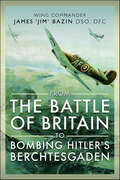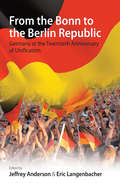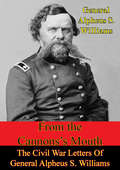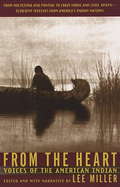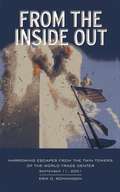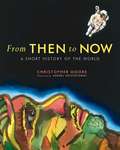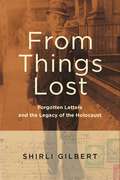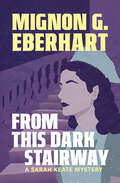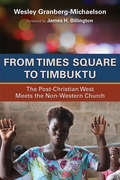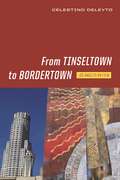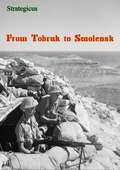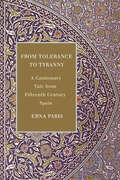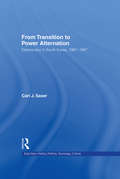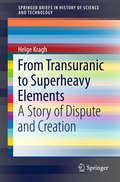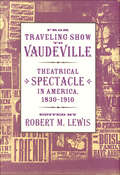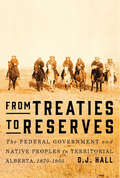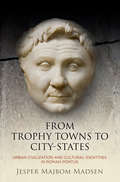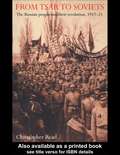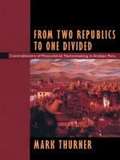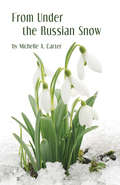- Table View
- List View
From The Battle of Britain to Bombing Hitler's Berchtesgaden: Wing Commander James 'jim' Bazin, Dso, Dfc
by James BazinIt was Tuesday, 17 October 1939. Britain had been at war with Germany for more than a month and for only the second time the Luftwaffe had dared to enter British airspace – and at last James ‘Jim’ Bazin’s chance had come. After joining the RAF in 1935, Jim was an experienced pilot when war broke out and he was eager to test his skills against the enemy. This first combat was the start of a career which saw Wing Commander Bazin, as he was to become, being posted to France with 607 (County of Durham) Squadron. He fought there until the last days of the Battle of France. In the course of the campaign, Bazin had battled his way to becoming an ace. He was also shot down behind enemy lines, but successfully evaded capture to return to his squadron and resume the fight. There was no respite for Bazin as he was once again in the air defending Britain’s skies in his trusty Hurricane as the Luftwaffe sort to destroy Fighter Command in the summer of 1940. With ten ‘kills’ to his name, Jim Bazin was awarded the Distinguished Flying Cross in October that year. But merely driving off the Luftwaffe was not enough for him. He was posted to Inverness where he served as a Controller in 14 Group’s Operations Room, which gave him a taste for offensive operations. In time, Bazin volunteered to move to Bomber Command. He duly undertook a conversion course in 1943, eventually joining 49 Squadron as a Lancaster pilot to take the war to the very heart of the enemy. After commanding 49 Squadron, including taking part in Bomber Command’s support of the D-Day landings, Bazin was promoted to Wing Commander, leading 9 Squadron on many attacks on special targets such as U-boat pens, viaducts, refineries and, most notably, operating with the famous Dambusters against Hitler’s great battleship Tirpitz. Unrelenting in his efforts against the enemy, Jim Bazin was involved in operations against targets in Poland and Germany right up until the end of the war. This culminated in the last major RAF operation of the Second World War when, on 25 April 1945, Bomber Command attacked the Berghof, Hitler’s Alpine retreat, and other targets in Berchtesgaden. Jim Bazin was awarded the DSO in September 1945 – rightful recognition for a man who had done so much to bring about the defeat of the enemy.
From The Bonn To The Berlin Republic
by Eric Langenbacher Jeffrey AndersonThe fall of the Berlin Wall and the unification of East and West Germany in 1989/90 were events of world-historical significance. The twentieth anniversary of this juncture represents an excellent opportunity to reflect upon the evolution of the new Berlin Republic. Given the on-going significance of the country for theory and concept-building in many disciplines, an in-depth examination of the case is essential. In this volume, unique in its focus on all aspects of contemporary Germany - culture, historiography, society, politics and the economy - top scholars offer their assessments of the country's performance in these and other areas and analyze the successes and continued challenges.
From The Cannon’s Mouth: The Civil War Letters Of General Alpheus S. Williams
by Milo M. Quaife General Alpheus S. WilliamsA candidate for the title of "unsung hero" among the Union generals of the Civil War, Alpheus Williams, "Old Pap" to his men, wrote as frequently as he could to his family in Detroit of his successes, achievements and battles during that terrible period of strife. In this engaging collection of his correspondence he recounts the part he played in the battles both East and West at Second Bull Run, Antietam, Chancellorsville, Gettysburg, Atlanta and the Savannah campaign. A kind hearted man, he was deeply affected by the hardships suffered by the common soldiers under his command who he treated with great care and often sorrow at the awful casualties they suffered.Warmly recommended."Superb war letters. . . . Old 'Pap' Williams possessed an unconscious literary flair that gives simple style and force to his letters. . . . Milo Quaife has added annotation that will enlighten the casual reader and satisfy the scholar."--New York Times Book Review"Civil War scholars are always grateful for a volume of letters written by a high-ranking officer who held important commands in pivotal engagements. . . . A superior collection. . . . Especially useful to students of the war are his keen, detailed accounts of Antietam, Chancellorsville, and Gettysburg."--American Historical Review
From The Heart
by Lee MillerExcerpts from Native American speeches--by Moctezuma, Tecumseh, Cochise, Sitting Bull, and others--accompanied by commentary by non-Indian observers, provide an eloquent overview of five hundred years of fateful encounters between Europeans and Native Americans. Reprint. AB.
From The Inside Out: Harrowing Escapes From The Twin Towers Of The World Trade Center
by Erik O. Ronningen8:46 AM ". . . there is something not right, out of order, about the view, Tad Hanc noticed from his 86th-floor windows looking north. Studying the magnificent Manhattan skyline, Tad began to take it in. And then it registered in all its horrifying aspects. Lowering his eyes slightly, Tad saw a large passenger airliner heading due south over Fifth Avenue just missing the top of the Empire State Building, flying very, very fast-heading straight toward Tower One-directly to his office-aimed right at him!" This is but one of fifteen heart-stopping stories the author has included in From The Inside Out Harrowing Escapes from the Twin Towers of the World Trade Center. From the oral accounts of people who began that morning living their normal, everyday lives, this book is a valuable collection of the human experience-documenting that intangible essence of bravery, selflessness, and generosity of spirit that exists, often dormant inside us all, rising to the forefront in times of crisis.
From Then to Now: A Short History of the World
by Christopher MooreTraces human civilization from early bands of hunter-gatherers to the multicultural world cities of the present, covering the development of agriculture, empires, law, and the major religions, the rise of Europe, colonies, and industrialization.
From Things Lost: Forgotten Letters and the Legacy of the Holocaust
by Shirli GilbertIn May 1933, a young man named Rudolf Schwab fled Nazi-occupied Germany. His departure allegedly came at the insistence of a close friend who later joined the Party. Schwab eventually arrived in South Africa, one of the few countries left where Jews could seek refuge, and years later, resumed a relationship in letters with the Nazi who in many ways saved his life. From Things Lost: Forgotten Letters and the Legacy of the Holocaust is a story of displacement, survival, and an unlikely friendship in the wake of the Holocaust via an extraordinary collection of letters discovered in a forgotten trunk. Only a handful of extended Schwab family members were alive in the war’s aftermath. Dispersed across five continents, their lives mirrored those of countless refugees who landed in the most unlikely places. Over years in exile, a web of communication became an alternative world for these refugees, a place where they could remember what they had lost and rebuild their identities anew. Among the cast of characters that historian Shirli Gilbert came to know through the letters, one name that appeared again and again was Karl Kipfer. He was someone with whom Rudolf clearly got on exceedingly well—there was lots of joking, familiarity, and sentimental reminiscing. “That was Grandpa’s best friend growing up,” Rudolf’s grandson explained to Gilbert; “He was a Nazi and was the one who encouraged Rudolf to leave Germany. . . . He also later helped him to recover the family’s property.” Gilbert takes readers on a journey through a family’s personal history wherein we learn about a cynical Karl who attempts to make amends for his “undemocratic past,” and a version of Rudolf who spends hours aloof at his Johannesburg writing desk, dressed in his Sunday finest, holding together the fragile threads of his existence. The Schwab family’s story brings us closer to grasping the complex choices and motivations that—even in extreme situations, or perhaps because of them—make us human. In a world of devastation, the letters in From Things Lost act as a surrogate for the gravestones that did not exist and funerals that were never held. Readers of personal accounts of the Holocaust will be swept away by this intimate story.
From This Dark Stairway (The Sarah Keate Mysteries)
by Mignon G. EberhartThis classic mystery “could rob at least one night’s sleep. . . . The scene is laid in a hospital and the things that happen there are terrifying in the extreme” (The New York Times).Nothing gets past the vigilance of Sarah Keate, head nurse on the third floor of Melady Memorial Hospital, a wing devoted to the wealthiest class of patients. Except one hot July night, she is startled to discover a patient has gone missing. And not just any patient, Peter Melady, grandson of the hospital’s founder and head of the Melady Drug Company. During her frantic search, Nurse Keate stumbles upon the bloodied corpse of Dr. Harrigan, who was to perform the missing patient’s surgery that very night.It’s a mystery as baffling as it is terrifying, made worse by the bumbling police officer on the case. Good thing the keen mind of Nurse Keate is gathering details, from the mad whispers heard moments before the murder to the antique Chinese snuff bottle Peter Melady demanded she retrieve before his disappearance. Nothing escapes Sarah’s shrewd notice, not even the cold-blooded calculations of a killer.
From This Day Forward
by Deborah CoxMAIL-ORDER BRIDE Caroline Marshall had taken a terrible chance in marrying a stranger by proxy. Of course, Jason Sinclair wasn't really a stranger-hadn't she fallen in love with him through his touching letters? But here, on a remote coffee plantation in the Amazon jungle, she encountered a man as forbidding and unpredictable as the land itself. Now that she was Mrs. Sinclair, there was no turning back. Jason had requested a bride who was quiet, obedient, and chaste; Caroline was none of these. But she'd seen desire smoldering in his gaze, and feared that passion so long denied might consume them both.
From This Day Forward
by Victoria ThompsonFrom Romantic Times Career Achievement Award Winner and New York Times bestseller Victoria Thompson, a magnificent historical romance set on a Texas plantation during the Civil War. It is an unforgettable tale of two men and one woman...of honor lost and won...of a love that will steal your heart... A fateful night during the Yankee's invasion of Texas changes young Lori McClintock's life forever, her innocence stolen and a baby on the way...while the unknowing father, Eric Ross, is off fighting with the Cavalry of the West. When Eric's older brother offers to marry her, Lori is stunned. She's fantasized about Adam Ross noticing her, of living on his beautiful estate and of being adored by a man she's adored her whole life. But Lori, with a baby to think of, has to be more realistic--Adam is a Southern gentleman who will take care of any child with his family's name. Now a battle has been ignited between brothers--careening toward an explosive end...threatening to expose a long-buried family secret...and awakening a ravenous passion not in one man, but in two...
From Tiberius to the Antonines: A History of the Roman Empire AD 14-192 (Routledge Revivals)
by Albino GarzettiThe first two centuries of the Christian era were largely a period of consolidation for the Roman Empire. However, the history of the heyday of Roman imperium is far from dull, for Augustus’ successors ranged from capable administrators - Tiberius, Claudius and Hadrian - to near-madmen like Caligula and the amateur gladiator Commodus, who might have wrecked the system but for its inherent strength. Albino Garzetti’s classic From Tiberius to the Antonines, first published in 1960, presents a definitive account of this fascinating period, which combines a clear and readable narrative with a thorough discussion of the methodological problems and primary sources. Regarding difficult historical questions, it can be relied upon for careful and reasonable judgments based on a full mastery of an immense amount of material. Nearly three hundred pages of critical notes and a comprehensive bibliography complement the text, ensuring its continuing relevance for all students of Roman history.
From Times Square to Timbuktu: The Post-Christian West Meets the Non-Western Church
by Wesley Granberg-MichaelsonIn the last century, amazingly, world Christianity's center of gravity has effectively moved from Europe to a point near Timbuktu in Africa. Never in the history of Christianity has there been such a rapid and dramatic shift in where Christians are located in the world.Wesley Granberg-Michaelson explores the consequences of this shift for congregations in North America, specifically for the efforts to build Christian unity in the face of new and challenging divisions. Centers of religious power, money, and theological capital remain entrenched in the global, secularized North while the Christian majority thrives and rapidly grows in the global South. World Christianity's most decisive twenty-first-century challenge, Granberg-Michaelson argues, is to build meaningful bridges between faithful churches in the global North and the spiritually exuberant churches of the global South.Watch the trailer:
From Tinseltown to Bordertown: Los Angeles on Film (Contemporary Approaches to Film and Media Series)
by Celestino DeleytoLos Angeles is a global metropolis whose history and social narrative is linked to one of its top exports: cinema. L.A. appears on screen more than almost any city since Hollywood and is home to the American film industry. Historically, conversations of social and racial homogeneity have dominated the construction of Los Angeles as a cosmopolitan city, with Hollywood films largely contributing to this image. At the same time, the city is also known for its steady immigration, social inequalities, and exclusionary urban practices, not dissimilar to any other borderland in the world. The Spanish names and sounds within the city are paradoxical in relation to the striking invisibility of its Hispanic residents at many economic, social, and political levels, given their vast numbers. Additionally, the impact of the 1992 Los Angeles riots left the city raw, yet brought about changing discourses and provided Hollywood with the opportunity to rebrand its hometown by projecting to the world a new image in which social uniformity is challenged by diversity. It is for this reason that author Celestino Deleyto decided to take a closer look at how the quintessential cinematic city contributes to the ongoing creation of its own representation on the screen. From Tinseltown to Bordertown: Los Angeles on Film starts from the theoretical premise that place matters. Deleyto sees film as predominantly a spatial system and argues that the space of film and the space of reality are closely intertwined in complex ways and that we should acknowledge the potential of cinema to intervene in the historical process of the construction of urban space, as well as its ability to record place. The author asks to what extent this is also the city that is being constructed by contemporary movies. From Tinseltown to Bordertown offers a unique combination of urban, cultural, and border theory, as well as the author’s direct observation and experience of the city’s social and human geography with close readings of a selection of films such as Falling Down, White Men Can’t Jump, and Collateral. Through these textual analyses, Deleyto tries to situate filmic narratives of Los Angeles within the city itself and find a sense of the “real place” in their fictional fabrications. While in a certain sense, Los Angeles movies continue to exist within the rather exclusive boundaries of Tinseltown, the special borderliness of the city is becoming more and more evident in cinematic stories. Deleyto’s monograph is a fascinating case study on one of the United States’ most enigmatic cities. Film scholars with an interest in history and place will appreciate this book.
From Tobruk to Smolensk
by StrategicusOriginally published in 1941, this book represents the third volume in a series on the course of World War II, by a well-informed author who chose to remain anonymous during the time of first publication. The period covered in this volume is roughly from February to August 1941. It is the sequel to The War for World Power and From Dunkirk to Benghazi and, according the author's Preface, "has been written upon the same broad lines as an attempt to disentangle from the amazing confusion of events those which are the most significant and, while there has been some endeavour to admit the jurisdiction of chronology, events have been grouped as far as possible in episodes that have a certain unity."It differs from the preceding volumes in showing the decisive character of the operations. From more concentrated though skilful operations it developed into movements which for mass and momentum have no parallel in history. It has the sort of discontinuity that exists between the art of the miniaturist and that of the scene painter; and yet it is evident that the attitudes and outlooks that conditioned earlier military operations dominated these. It can hardly fail to be realized that the attitude towards defence that caused the fall of France would have led to defeat throughout this period and that the Russians escaped defeat and inflicted damage on their opponents in the measure that they attacked and in so far as they failed it was due to their acting upon the defensive."
From Tolerance to Tyranny: A Cautionary Tale from Fifteenth-Century Spain
by Erna ParisOne thousand years ago, a civilization existed in Spain that was famed throughout Europe. To the horror of the Christian rulers to the north, Jews, Christians, and Moors lived together in harmony — and in doing so they created one of the most extraordinary societies the West has ever known. In the span a few hundred years, however, Spain would transform itself from a pluralistic, multicultural society to the least tolerant nation in Europe. By the end of the fifteenth century, the Spanish Inquisition had established a reign of terror, and the Jews were expelled from the land they had inhabited for 1,500 years. Eventually the Moors, or Arabs, were banned as well. The tragic configuration of events that turned a culture of tolerance into an autocratic police state was effectively repeated centuries later in Nazi Germany, in Occupied France, and even in places closer to home. From Tolerance to Tyranny is a gripping tale of a long-ago era whose familiar echoes continue to resound today. Paris tackles the subject of majority-minority relations in mixed societies, focusing on the humanity of the players even as she exposes the pitfalls of their ideals.
From Transition to Power Alternation: Democracy in South Korea, 1987-1997 (East Asia: History, Politics, Sociology and Culture)
by Carl SaxerFirst Published in 2002. Routledge is an imprint of Taylor & Francis, an informa company.
From Transuranic to Superheavy Elements
by Helge KraghThe story of superheavy elements - those at the very end of the periodic table - is not well known outside the community of heavy-ion physicists and nuclear chemists. But it is a most interesting story which deserves to be known also to historians, philosophers, and sociologists of science and indeed to the general public. This is what the present work aims at. It tells the story or rather parts of the story, of how physicists and chemists created elements heavier than uranium or searched for them in nature. And it does so with an emphasis on the frequent discovery and naming disputes concerning the synthesis of very heavy elements. Moreover, it calls attention to the criteria which scientists have adopted for what it means to have discovered a new element. In this branch of modern science it may be more appropriate to speak of creation instead of discovery. The work will be of interest to scientists as well as to scholars studying modern science from a meta-perspective.
From Traveling Show to Vaudeville: Theatrical Spectacle in America, 1830–1910
by Robert M. LewisBefore phonographs and moving pictures, live performances dominated American popular entertainment. Carnivals, circuses, dioramas, magicians, mechanical marvels, musicians, and theatrical troupes—all visited rural fairgrounds, small-town opera houses, and big-city palaces around the country, giving millions of people an escape from their everyday lives for a dime or a quarter. In From Traveling Show to Vaudeville, Robert M. Lewis has assembled a remarkable collection of nineteenth- and early twentieth-century primary sources that document America's age of theatrical spectacle. In eight parts, Lewis explores, in turn, dime museums, minstrelsy, circuses, melodramas, burlesque shows, Wild West shows, amusement parks, and vaudeville.Included in this compendium are biographies, programs, ephemera produced by theatrical entrepreneurs to lure audiences to their shows, photographs, scripts, and song lyrics as well as newspaper accounts, reviews, and interviews with such figures as P. T. Barnum and Buffalo Bill Cody. Lewis also gives us reminiscences about and reactions to various shows by members of audiences, including such prominent writers as Mark Twain, William Dean Howells, Nathaniel Hawthorne, Carl Sandburg, Walt Whitman, Louisa May Alcott, Charles Dickens, O. Henry, and Maxim Gorky. Each section also includes a concise introduction that places the genre of spectacle into its historical and cultural context and suggests major interpretive themes. The book closes with a bibliographic essay that identifies relevant scholarly works.Many of the pieces collected here have not been published since their first appearance, making From Traveling Show to Vaudeville an indispensable resource for historians of popular culture, theater, and nineteenth-century American society.
From Treaties to Reserves
by D. J. HallThough some believe that the Indian treaties of the 1870s achieved a unity of purpose between the Canadian government and First Nations, in From Treaties to Reserves D.J. Hall asserts that - as a result of profound cultural differences - each side interpreted the negotiations differently, leading to conflict and an acute sense of betrayal when neither group accomplished what the other had asked. Hall explores the original intentions behind the government's policies, illustrates their attempts at cooperation, and clarifies their actions. While the government believed that the Aboriginal peoples of what is now southern and central Alberta desired rapid change, the First Nations, in contrast, believed that the government was committed to supporting the preservation of their culture while they adapted to change. Government policies intended to motivate backfired, leading instead to poverty, starvation, and cultural restriction. Many policies were also culturally insensitive, revealing misconceptions of Aboriginal people as lazy and over-dependent on government rations. Yet the first two decades of reserve life still witnessed most First Nations people participating in reserve economies, many of the first generation of reserve-born children graduated from schools with some improved ability to cope with reserve life, and there was also more positive cooperation between government and First Nations people than is commonly acknowledged. The Indian treaties of the 1870s meant very different things to government officials and First Nations. Rethinking the interaction between the two groups, From Treaties to Reserves elucidates the complexities of this relationship.
From Treaties to Reserves: The Federal Government and Native Peoples in Territorial Alberta, 1870-1924
by D.J. HallThough some believe that the Indian treaties of the 1870s achieved a unity of purpose between the Canadian government and First Nations, in From Treaties to Reserves D.J. Hall asserts that - as a result of profound cultural differences - each side interpreted the negotiations differently, leading to conflict and an acute sense of betrayal when neither group accomplished what the other had asked. Hall explores the original intentions behind the government's policies, illustrates their attempts at cooperation, and clarifies their actions. While the government believed that the Aboriginal peoples of what is now southern and central Alberta desired rapid change, the First Nations, in contrast, believed that the government was committed to supporting the preservation of their culture while they adapted to change. Government policies intended to motivate backfired, leading instead to poverty, starvation, and cultural restriction. Many policies were also culturally insensitive, revealing misconceptions of Aboriginal people as lazy and over-dependent on government rations. Yet the first two decades of reserve life still witnessed most First Nations people participating in reserve economies, many of the first generation of reserve-born children graduated from schools with some improved ability to cope with reserve life, and there was also more positive cooperation between government and First Nations people than is commonly acknowledged. The Indian treaties of the 1870s meant very different things to government officials and First Nations. Rethinking the interaction between the two groups, From Treaties to Reserves elucidates the complexities of this relationship.
From Trophy Towns to City-States: Urban Civilization and Cultural Identities in Roman Pontus (Empire and After)
by Jesper Majbom MadsenIn 66 BCE, in the woods of Armenia Minor, Pompey the Great defeated Mithridates VI Eupator, making him one of the most successful Roman generals of all time. The victory presented him with the enormous challenge of organizing not only Mithridates' kingdom but also large parts of Anatolia and the Near East that were now placed under Roman rule. Pompey's solution was to found six new cities and to convert two existing communities, Zela, a temple community dedicated to the goddess Anaïtis, and Amaseia, the former royal residence, into cities as well. There would now be eight city-states, each with the responsibility of administering the territory known to the Romans as Pontus.It has often been argued that in their eastern provinces the Romans based newly founded cities on the model of the Greek city-state and that Roman culture had less influence there than in the West. Jesper Majbom Madsen, however, describes civic development in Roman Pontus as a process by which Roman and Greek elements were introduced simultaneously. He contends that the Pompeian cities were neither traditional Greek poleis nor entirely Roman settlements with Roman laws and legislation; nor were they Greek cities gradually influenced by Roman rule. Instead, they represented a third category, in which a citizen could be an Anatolian, Greek, and Roman at the same time as well as a member of the elite, a priest in the imperial cult and in a cult to Asclepius, a local politician and a member of the Pontic koinon, all without contradiction.Bringing together a wide range of literary, historical, and political sources, From Trophy Towns to City-States examines how Pompey's cities were initially organized, how they developed over time, and how inhabitants in this part of the Roman Empire defined themselves culturally and politically.
From Tsar To Soviets: The Russian People And Their Revolution, 1917-1921
by Christopher ReedWritten from the perspective of the factory worker and peasant at the ground level, this study of Russia during the Revolution 1917-21 aims to shed light on the realities of living through and participating in these tumultuous events. The book is intended for undergraduate courses in history, Soviet studies, and politics.
From Turnbull to Morrison: Understanding the Trust Divide
by Mark Evans Michelle Grattan Brendan McCaffrieIs trust between the government and Australians broken? The country's leading institutions have been ranked among the least trusted in the world at a time when the economy has experienced twenty-seven years of economic growth. This has all happened since the 2016 federal election under the revolving prime ministerships of Malcolm Turnbull and Scott Morrison's first term. Turnbull was the fourth sitting prime minister in a decade to be removed by his own party. What role do these politically turbulent times play in this trust deficit? Scott Morrison has now been elected by the people. What does he and future prime ministers need to do to reboot civic belief in politics? How will history judge the contribution of the Turnbull and Morrison administrations? In From Turnbull to Morrison well-known political journalists including Michelle Grattan, George Megalogenis, Megan Davis, Virginia Haussegger, Mark Kenny and Katharine Murphy and leading academics such as Frank Bongiorno, Mark Evans, Susan Harris-Rimmer, Anne Tiernan, John Warhurst and George Williams examine the institutions, the issues and the leaders at the heart of this crisis. It is crucial reading for champions of liberal democracy. From Turnbull to Morrison: The Trust Divide is the thirteenth volume of Australia's longest running study of Australian Commonwealth Government, started in 1983.
From Two Republics to One Divided: Contradictions of Postcolonial Nationmaking in Andean Peru
by Mark ThurnerFrom Two Republics to One Divided examines Peru's troubled transition from colonial viceroyalty to postcolonial republic from the local perspective of Andean peasant politics. Thurner's reading of the Andean peasantry's engagement and disengagement with the postcolonial state challenges long-standing interpretations of Peruvian and modern Latin American history and casts a critical eye toward Creole and Eurocentric ideas about citizenship and nationalism.Working within an innovative and panoramic historical and linguistic framework, Thurner examines the paradoxes of a resurgent Andean peasant republicanism during the mid-1800s and provides a critical revision of the meaning of republican Peru's bloodiest peasant insurgency, the Atusparia Uprising of 1885. Displacing ahistorical and nationalist readings of Inka or Andean continuity, and undermining the long-held notion that the colonial legacy is the dominant historical force shaping contemporary Andean reality, Thurner suggests that in Peru, the postcolonial legacy of Latin America's nation-founding nineteenth century transfigured, and ultimately reinvented, the colonial legacy in its own image.
From Under the Russian Snow
by Michelle A CarterAt age 50, Michelle Carter, a married mother of two adult children, left her job as editor of a suburban newspaper in the San Francisco Bay area to move to Russia for a year as a United States Information Agency Journalist-in-Residence. There she worked with newspaper editors who struggled to adapt to the new concepts of press freedom and a market economy. She became an on-the-scene witness to the second great Russian revolution. At the same time, she embarked on a personal journey that wrenched her life in a way she could never have anticipated when she accepted her husband's challenge to take the assignment.
